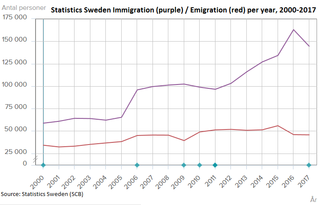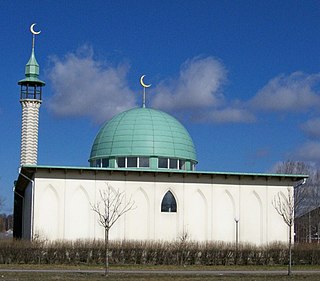
Demographic features of the population of Denmark include ethnicity, education level, health of the populace, economic status, religious affiliations, and other aspects.

The demographics of Finland is monitored by the Statistics Finland. Finland has a population of over 5.6 million people, ranking it 19th out of 27 within the European Union. The average population density in Finland is 19 inhabitants per square kilometre (49/sq mi), making it the third most sparsely populated country in Europe, after Iceland and Norway. Population distribution is extremely uneven, with the majority of the population concentrated in the southern and western regions of the country. The majority of the Finnish population - approximately 73% - lives in urban areas. Approximately 1.6 million, or almost 30%, reside solely in the Helsinki Metropolitan Area. Conversely, the Arctic Lapland region contains only two inhabitants per square kilometre (5.2/sq mi).

The demography of Sweden is monitored by the Statistiska centralbyrån. Sweden's population was 10,538,026, making it the 15th-most populous country in Europe after Czech Republic, the 10th-most populous member state of the European Union, and the 87th-most populous country in the world. The total fertility rate was rated at 1.66 in 2020, which is far below the replacement rate of 2.1.

Demographic features of the population of Norway include population density, ethnicity, education level, health of the populace, economic status, religious affiliations and other aspects.

Demographic features of the population of the Netherlands include population density, ethnicity, education level, health of the population, economic status, religious affiliations and other aspects of the population.

The South African diaspora consists of South African emigrants and their descendants living outside South Africa. The largest concentrations of South African emigrants are to be found in the United Kingdom, Australia, the United States and the United Arab Emirates. At the time of the 2021 United Kingdom census, 217,180 residents of England and Wales were born in South Africa. In Australia, there were 189,207 South African-born people living in the country at the moment of the 2021 Census. The 2021 American Community Survey identified 123,461 South African-born residents of the country.

Colombians are people identified with the country of Colombia. This connection may be residential, legal, historical or cultural. For most Colombians, several of these connections exist and are collectively the source of their being Colombian.

Immigration to Romania is less common than immigration to most other European Union countries, with Romania having 2.1% of the population foreign born as of 2017. Of these, 0.9% were born in other EU member states, and 1.2% were born outside the EU. Romania has recently experienced a growing wave of immigration, mostly from the Republic of Moldova, Turkey, Italy, Spain, Southeast Asia, and East Asia and to a lesser extent other parts of the world. In 2013, there were 198,839 immigrants living in Romania, of which 13,000 were refugees. As of mid-2020, the number of migrants in Romania was 705,000, of which over 40% were from the Republic of Moldova.

The Iraqi diaspora refers to native Iraqis who have left for other countries as emigrants or refugees, and is now one of the largest in modern times, being described by the UN as a "humanitarian crisis" caused by the 1991 Gulf War and 2003 invasion of Iraq and by the ensuing war.

Immigration to Europe has a long history, but increased substantially after World War II. Western European countries, especially, saw high growth in immigration post 1945, and many European nations today have sizeable immigrant populations, both of European and non-European origin. In contemporary globalization, migrations to Europe have accelerated in speed and scale. Over the last decades, there has been an increase in negative attitudes towards immigration, and many studies have emphasized marked differences in the strength of anti-immigrant attitudes among European countries.
Iraqis are the second largest minority group living in Sweden, with 146,048 Iraqi-born people living in Sweden and 79,732 Swedes with at least one Iraqi-born parent. They are also one of the largest Asian communities in the country. The size of this group has doubled in the period of 2002 to 2009; the influx of Iraqi refugees increased dramatically from 2006 to 2009 as a result of the US-led invasion of Iraq.
In 2017, Norway's immigrant population consisted of 883,751 people, making up 16.8% of the country's total population. Of this number, 724,987 are foreign-born, while 158,764 are Norwegian-born with foreign-born parents. The ten most common countries of origin of immigrants residing in Norway are Poland (97,197), Lithuania (37,638), Sweden (36,315), Somalia (28,696), Germany (24,601), Iraq (22,493), Syria (20,823), Philippines (20,537), Pakistan (19,973) and Eritrea (19,957). The immigrant population comprises people from a total of 221 countries and autonomous regions, but 25% of the immigrants are from one of four migrant groups: Polish, Lithuanians, Swedes and Somalis.

Immigration to Finland is the process by which people migrate to Finland to reside in the country. Some, but not all, become Finnish citizens. Immigration has been a major source of population growth and cultural change throughout much of the history of Finland. The economic, social, and political aspects of immigration have caused controversy regarding ethnicity, economic benefits, jobs for non-immigrants, settlement patterns, impact on upward social mobility, crime, and voting behaviour.

Immigration to Sweden is the process by which people migrate to Sweden to reside in the country. Many, but not all, become Swedish citizens. The economic, social, and political aspects of immigration have caused some controversy regarding ethnicity, economic benefits, jobs for non-immigrants, settlement patterns, impact on upward social mobility, violence, and voting behaviour.
African immigrants to Sweden include naturalized citizens and residents of Sweden who were born in Africa. As of 2020, there are 236,975 people in Sweden who were born in Africa. By 2022, this number rose to 250,881 residents of Sweden who were born in Africa, or approximately 3% of the total population.
Indians in Sweden are citizens and residents of Sweden who are of Indian descent.

Crime in Norway is countered by Norway's law enforcement agencies.

Arabs in Sweden are citizens and residents of Sweden who emigrated from nations in the Arab world. They represent 5.3% of the total population of the country. About a quarter of Arabs in Sweden are Christians.
Syrians in Sweden are citizens and residents of Sweden who are of Syrian descent. As of 2019, there were 191,530 residents of Sweden born in Syria, and 50,620 born in Sweden with at least one Syrian-born parent.
Latin American migration to Europe is the diaspora of Latin Americans to the continent of Europe, dating back to the first decades of the Spanish and Portuguese empires in the Americas. Latin Americans in Europe are now a rapidly growing group consisting of immigrants from Argentina, Bolivia, Brazil, Chile, Colombia, Costa Rica, Cuba, Dominican Republic, Ecuador, El Salvador, Guatemala, Honduras, Mexico, Nicaragua, Panama, Paraguay, Peru, Puerto Rico, Uruguay and Venezuela. It may also include individuals from certain French-speaking territories depending on the definition of Latin America used.














